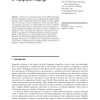Free Online Productivity Tools
i2Speak
i2Symbol
i2OCR
iTex2Img
iWeb2Print
iWeb2Shot
i2Type
iPdf2Split
iPdf2Merge
i2Bopomofo
i2Arabic
i2Style
i2Image
i2PDF
iLatex2Rtf
Sci2ools
ALIFE
2006
2006
Understanding Linguistic Evolution by Visualizing the Emergence of Topographic Mappings
We show how cultural selection for learnability during the process of linguistic evolution can be visualized using a simple iterated learning model. Computational models of linguistic evolution typically focus on the nature of, and conditions for, stable states. We take a novel approach and focus on understanding the process of linguistic evolution itself. What kind of evolutionary system is this process? Using visualization techniques, we explore the nature of replicators in linguistic evolution, and argue that replicators correspond to local regions of regularity in the mapping between meaning and signals. Based on this argument, we draw parallels between phenomena observed in the model and linguistic phenomena observed across languages. We then go on to identify issues of replication and selection as key points of divergence in the parallels between the processes of linguistic evolution and biological evolution.
| Added | 10 Dec 2010 |
| Updated | 10 Dec 2010 |
| Type | Journal |
| Year | 2006 |
| Where | ALIFE |
| Authors | Henry Brighton, Simon Kirby |
Comments (0)

